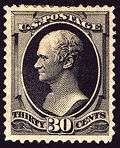Alexander Hamilton (Ceracchi)
Alexander Hamilton is a marble bust portrait of Alexander Hamilton, done in the style of a Roman Senator, by the Italian sculptor Giuseppe Ceracchi.[1] Ceracchi also created many replicas, in both marble and plaster. The bust was later used as a model for sculptures and paintings.
| Alexander Hamilton | |
|---|---|
 | |
| Artist | Giuseppe Ceracchi |
| Year | 1794 |
| Type | Sculpture |
| Medium | White marble |
| Subject | Alexander Hamilton |
| Dimensions | 63.5 cm × 35.6 cm × 30.5 cm (25.0 in × 14.0 in × 12.0 in) |
History
Ceracchi created a terracotta model of Hamilton, from life, about 1791–92.[2] This was subsequently sent to Rome, where he created the marble version. As written to Hamilton in July 1792, Ceracchi was "impatient to receive the clay that I had the satisfaction of forming from your witty and significant physiognomy".[3] He returned to deliver the bust to Hamilton in 1794. He did not receive payment until later. On March 3, 1796, Hamilton wrote in his cash-book: "for this sum through delicacy paid upon cherachi’s draft for making my bust on his own importunity & as a favour to him $620"[4]
The Hamilton family kept the bust until 1896 when it was bequeathed to the New York Public Library along with the portrait painting of George Washington, The Constable-Hamilton Portrait, by Gilbert Stuart.[5] Both were sold together, as requested by the will, on November 30, 2005 to the Crystal Bridges Museum of American Art for over $8 million.[2]
A copy of the bust is now housed at Hamilton Grange, in New York City. The original is displayed at the Crystal Bridges Museum of American Art in Bentonville, Arkansas.
Description
Ceracchi portrayed Hamilton in the style of a Roman Senator, with wavy hair and bare-chested, wearing a ribbon of the Order of the Cincinnati over his right shoulder.[1][2]
Inscription
The original work is inscribed on the back in Latin:[5]
DE FACIE PHILADELPHIAE |
This translates to "Executed in Philadelphia and copied in Florence, Executed by Joseph Ceracchi, 1794."[2]
Legacy
The painter John Trumbull used the bust as model for a series of 1804–1808 portraits of Hamilton.[6][7]
The first U.S. Postal Service stamp to honor Hamilton was an 1870 30-cent stamp using this bust as a model.[8]
In 1880, the bust owned by Hamilton's son, John C. Hamilton, was used as a model for the head of the granite statue by Carl Conrads.[9]
At the Hamilton Grange National Memorial, the National Park Service has installed a touch-screen display that features an avatar modeled after Ceracchi's bust.[10]
While Ceracchi (born on July 4, 1751) created busts for several founding fathers, his life did not end well. After returning to Europe, he first celebrated Napoleon with a bust, but then turned against him. After an unsuccessful plot, Napoleon had him guillotined at the Place de Grève on January 30, 1801.[9][11]
Gallery
 Portrait by John Trumbull, 1806
Portrait by John Trumbull, 1806 30-cent U.S. stamp
30-cent U.S. stamp Statue by Carl Conrads
Statue by Carl Conrads
References
- "Alexander Hamilton, (sculpture)". Inventory of American Sculpture, Smithsonian Institution Research Information System. Smithsonian American Art Museum.
- "Treasury's Hamilton Bust". U.S. Department of the Treasury.
- Dearinger, David Bernard (2004). "Giuseppe Ceracchi". Paintings and Sculpture in the Collection of the National Academy of Design: 1826–1925. Hudson Hills Press. pp. 90–91. ISBN 1-55595-029-9.
- Hamilton, Alexander (July 25, 1795). "From Alexander Hamilton to Robert Troup, 25 July 1795". National Archives. note 6.
- "Property from the New York Public Library, Astor, Lenox and Tilden Foundations". Sotheby's. November 30, 2005. Archived from the original on August 7, 2016.
- Sizer, Theodore (1967). "Alexander Hamilton: Ceracchi Type". The Works of Colonel John Trumbull, Artist of the American Revolution. with the assistance of Caroline Rollins (Revised ed.). Yale University Press. pp. 37–8.
- "Alexander Hamilton, (Replica) (painting)". Inventory of American Sculpture, Smithsonian Institution Research Information System. Smithsonian American Art Museum.
- "30-cent Hamilton". National Postal Museum.
- "The Hamilton Statue. Its Unveiling To-day – The Bust After Which It Was Modeled". The New York Times. November 22, 1880.
- "Hamilton Comes to Life (and Death) On-screen". National Park Service.
- Roscoe, Ingrid; Hardy, Emma; Sullivan, M.G. "Giuseppe Ceracchi". Online Database of the Biographical Dictionary of Sculptors in Britain 1660–1851.
External links
| Wikimedia Commons has media related to Bust of Alexander Hamilton by Giuseppe Ceracchi. |
- "Alexander Hamilton, by Giuseppe Ceracchi". Crystal Bridges Museum of American Art.
- Torbert, Amy (2016). "Satisfied: Giuseppe Ceracchi's Bust of Alexander Hamilton". Crystal Bridges Museum of American Art.
- "Treasury's Hamilton Bust". U.S. Department of the Treasury.
- Dearinger, David Bernard (2004). "Giuseppe Ceracchi". Paintings and Sculpture in the Collection of the National Academy of Design: 1826–1925. Hudson Hills Press. pp. 90–91. ISBN 1-55595-029-9.